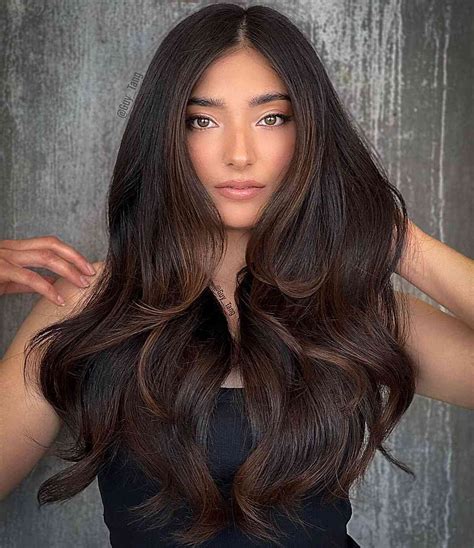Introduction

Dark hair exudes an air of sophistication and mystery, but it can also appear dull or flat without the right hair color. Whether you’re looking to enhance your natural locks or create a bold new look, choosing the best hair color for dark hair is crucial. In this comprehensive guide, we’ll explore the various options available and help you find the perfect shade to complement your skin tone and hair texture.
Finding Your Best Hair Color
When choosing a hair color for dark hair, several factors come into play, including:
- Skin tone: Warm skin tones work well with warm hair colors, such as caramel or copper. Cool skin tones are best paired with cool hair colors, such as ash brown or icy blonde.
- Hair texture: Coarse hair can handle bolder colors, while fine hair looks best with subtle highlights or lowlights.
- Personal style: Your hair color should reflect your personality and lifestyle. If you’re going for a subtle change, consider a few shades lighter or darker than your natural color. For a more dramatic look, opt for a contrasting color, such as blonde or red.
Types of Hair Color for Dark Hair
1. Permanent Hair Color
- Offers long-lasting results, up to 6-8 weeks
- Can damage hair, especially if not applied properly
- Requires regular touch-ups to maintain color
2. Semi-Permanent Hair Color
- Lasts for 6-8 washes
- Less damaging than permanent hair color
- Provides deeper tones and can enhance natural hair color
3. Demi-Permanent Hair Color
- Lasts for 12-24 washes
- Adds shine and vibrancy to hair
- Does not contain ammonia or peroxide, making it less damaging
4. Temporary Hair Color
- Washes out after 1-2 shampoos
- Can be used to experiment with different colors without commitment
- Can stain hair, so it’s best to use sparingly
Popular Hair Colors for Dark Hair
Brunette
- Classic Brunette: A rich, natural-looking brown that enhances dark hair without being too noticeable
- Warm Brunette: A brown shade with warm undertones, such as caramel or copper. This color can add warmth to the face and skin.
- Cool Brunette: A brown shade with cool undertones, such as ash brown or coffee. This color is ideal for those with cool skin tones.
Auburn
- Natural Auburn: A reddish-brown shade that occurs naturally in some people with dark hair. It can add depth and warmth to the hair.
- Intense Auburn: A vibrant, copper-red shade that creates a bold and glamorous look. It’s best suited for those with warm skin tones.
- Burgundy Auburn: A deep reddish-purple shade that adds a touch of mystery and sophistication. It’s a versatile color that can be tailored to suit different skin tones.
Blonde
- Warm Blonde: A golden or buttery blonde shade that complements warm skin tones. It can brighten up dark hair and add a touch of warmth.
- Cool Blonde: A platinum or icy blonde shade that complements cool skin tones. It can create a striking contrast with dark hair.
- Balayage Blonde: A technique that involves hand-painting highlights onto the hair, creating a natural-looking, sun-kissed effect.
Red
- Classic Red: A fiery, vibrant red shade that turns heads. It’s best suited for those with warm skin tones and bold personalities.
- Copper Red: A deep, metallic red shade that adds warmth and richness to dark hair. It’s a versatile color that can be worn by a variety of skin tones.
- Wine Red: A deep plum red shade that adds sophistication and elegance to dark hair. It’s a great choice for formal events or those with cooler skin tones.
Pros and Cons of Different Hair Colors for Dark Hair
| Hair Color | Pros | Cons |
|---|---|---|
| Brunette | Natural and versatile | Can be boring or flat if not done properly |
| Auburn | Adds warmth and depth | Can be high-maintenance and requires regular touch-ups |
| Blonde | Brightens up dark hair and creates a sun-kissed look | Can be damaging and require frequent upkeep |
| Red | Bold and glamorous | Can be difficult to remove and may fade quickly |
How to Choose the Best Hair Color for Dark Hair
- Consider your skin tone: Warm skin tones work best with warm hair colors, while cool skin tones complement cool hair colors.
- Take into account your hair texture: Coarse hair can handle bolder colors, while fine hair looks best with subtle highlights or lowlights.
- Think about your personal style: Choose a hair color that reflects your personality and lifestyle.
- Consult with a professional: A professional hairstylist can help you determine the best hair color for your individual needs and preferences.
Conclusion
Finding the best hair color for dark hair is not a one-size-fits-all solution. By considering your skin tone, hair texture, and personal style, you can choose a color that complements your natural features and creates the desired look. Whether you opt for a subtle change or a bold transformation, the right hair color can enhance your confidence and elevate your overall appearance.
